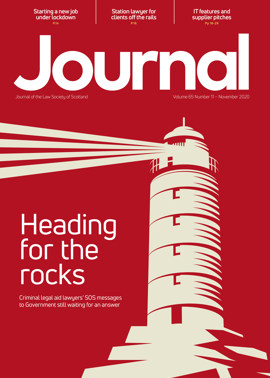Property pitfalls: problematic but preventable

One of the great truths of professional negligence is that there is often little relationship between the nature of the error and the cost of the consequence. Far more problems arise from what might be viewed as minor clerical or procedural errors than from ignorance of the law. And it’s absolutely the case that great big claims grow out of apparently tiny mistakes.
A review of some conveyancing cases from the archives of RSA, the Master Policy lead insurers, amply demonstrates that, and perhaps provides some useful guidance on how best to avoid the pitfalls of these relatively minor mistakes, and the substantial claims they have caused.
Assumptions can be very costly
The clients were delighted and excited when they instructed the solicitor to put in an offer on the house they had just been to see. After years in a flat far too small for their growing family, the house represented the first step towards their future. Amongst its best features was a large open plan kitchen/living/diningroom, ideal for family life. It was, they said, just perfect.
Happily the offer was accepted, and the solicitor took steps to progress the purchase. In particular, they sought assurance from the sellers’ agents that removal of the internal wall was fully compliant and documented. The missive clause on the point was deleted and correspondence provided from the local authority to the effect that a building warrant was not required as long as the wall was not loadbearing. The agents explained that this email was confirmation that no permissions were required for the removal.
Some time after the clients’ entry to the property, cracks began to appear in the ceiling. Structural investigations indicated that the property was shifting as a result of removal of the (loadbearing) wall.
A substantial claim was pursued against the solicitor for the cost of repairs to the property, including installation of steelwork to replace the missing wall, and the costs of obtaining formal documentation for the remedial works, together with various related losses. All of these costs – and indeed considerable grief to the clients – could have been avoided had the solicitor simply advised the clients to have a structural engineer check the position.
Check. Then check again
The solicitor acted for commercial lenders in connection with the refinancing of a complex security and lending package for a developer. The clients’ security was to rank behind that of another lender, but ahead of a further loan.
Unfortunately, though the complex security documentation was all drafted, prepared, signed and registered, the ranking agreement was left on the transaction file, and never sent to Companies House for registration. Following the appointment of administrators to the developer company, the lender clients expected to make a substantial recovery, but discovered instead that the lenders intended to rank behind them would scoop everything not due to the holders of the first security.
A claim was pursued against the solicitor, seeking the hundreds of thousands of pounds which would have been recovered had the ranking agreement been properly registered.
The situation could have been averted by a post-transaction review to ensure proper and effective registration of all of the security documentation.
Make the date
Business was booming for the solicitor’s clients, and the decision was reached to expand into new premises. Suitable premises were identified and secured, and instructions provided to the solicitor to serve a break notice for the existing property. The clients planned to exit the premises five years early, and a break clause in the lease allowed for termination, provided that proper notice was provided at least 12 months prior to the break date. A break notice was duly prepared by the solicitor, posted first class recorded delivery and received by the landlords’ agents. The solicitor then received a letter from solicitors on behalf of the landlords, saying that the break notice was ineffective.
It had, they said, been received a day late.
A careful check of the terms of the lease – and a calendar – confirmed the fact: the break notice was a day late, and the clients were now bound into the unwanted lease for a further five years.
The clients argued that they were now bound into their new lease, and that the future of the business was dependent on the expansion. Losses in excess of £1 million were alleged.
It’s worth noting that a number of similar claims have been received over the years. Whether acting for landlord or tenant, whether seeking to break a lease or extend it, it is vital to ensure that the notice is served in time to achieve the required notice, in the required format and on the right party.
These claims are inevitably expensive, and completely capable of being avoided.
Check the timeline
The solicitor acted for the purchaser of a flat, part of a substantial flatted development. Regulation of the larger property of which the flat formed a part was governed by a detailed deed of conditions, and the titles to each of the individual flats should have included reference to the deed of conditions.
Unfortunately, some of the flats, including the clients’, were sold prior to registration of the deed of conditions, and the titles contained no reference to it. Expert opinion confirmed that the flat was not burdened by the deed, and the proprietors were neither bound to its obligations nor entitled to its benefits.
The clients attempted to sell the property. While it attracted significant interest and several offers were received, a prospective sale fell through on examination of the titles. The absence of any regulation of the common parts was given as a reason for withdrawal.
While there is a sound argument that the title obtained for the clients was “good”, the clients alleged in their claim against the solicitor that the abortive sale was de facto proof that it was not “marketable”. After some delays, they were forced to reduce the sale price and obtain indemnity insurance in respect of the apparent defect in the title.
A simple check of the timeline and consideration of the titles in advance of purchase could have avoided this situation and the expensive claim it caused.
Any restrictions on use?
Converted properties can be successful homes and business premises. But it’s vital to ensure that the proposed new use is permitted under the titles.
The solicitor acted for a client who planned to operate a hairdressing and beauty salon at the property being purchased. This had formerly been a bank branch, and like many others was ripe for conversion after closure. Unfortunately, and unnoticed by the solicitor, the title contained a deed of conditions in terms of which use of the premises was restricted to the operation of a bank.
Very substantial costs were incurred in resolving the title position, which in addition massively delayed the opening of the salon. The client then made a claim against the solicitor, alleging losses into six figures as a result.
Sale under reservation
The clients instructed the solicitor in the sale of a development plot forming part of the family farm. It was intended that the necessary rights of access etc be preserved for the current use and potential future sale of the farmhouse and other areas of land.
It was only sometime later, in connection with a proposed sale of the farmhouse, that it was discovered that no rights had been reserved. The farmhouse was left effectively landlocked, with the obvious resultant impact on its value and saleability.
A claim was made against the solicitor for the difference in the value of the farmhouse with and without appropriate rights of access.
Again it is worth noting that the lead insurers, RSA, have seen numerous variations on this claim over the years. It’s vital when acting in the sale of only a part of any property to ensure that the remaining part retains all necessary rights and servitudes.
So what can we take from these examples? Clearly, that very small mistakes can lead to very substantial losses. But perhaps more importantly, that any and all of these claims could have been avoided by some fairly straightforward checks before completion of the transaction. Another set of eyes on the titles, a run through a checklist, a further check at a calendar. And ultimately that any claim, literally any claim, is better avoided than defended.
Regulars
Perspectives
Features
Briefings
- Civil court: keeping justice on the rails
- Employment: Time for a redundancy refresher
- Family: Watch your step with behaviour-based divorce
- Human rights: Inner House message in privacy group chat
- Pensions: The future – the regulator's blueprint
- Scottish Solicitors' Discipline Tribunal
- Crofting law reform: time to act
- In-house, online and in demand
In practice
- Paralegals: 10 years of recognition
- Ask Ash: Too busy, but still insecure
- Property pitfalls: problematic but preventable
- The Word of Gold: Count us out
- Prepare for the tax due date
- The Eternal Optimist: Help to turn the corner
- Appreciation: Ross Paton
- Appreciation: Claire Reilly (Robertson)
- Tenancies succession reminder






